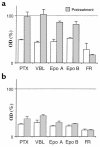Pretreatment with DNA-damaging agents permits selective killing of checkpoint-deficient cells by microtubule-active drugs
- PMID: 10683383
- PMCID: PMC289166
- DOI: 10.1172/JCI8625
Pretreatment with DNA-damaging agents permits selective killing of checkpoint-deficient cells by microtubule-active drugs
Abstract
Cell-cycle checkpoint mechanisms, including the p53- and p21-dependent G(2) arrest that follows DNA damage, are often lost during tumorigenesis. We have exploited the ability of DNA-damaging drugs to elicit this checkpoint, and we show here that such treatment allows microtubule drugs, which cause cell death secondary to mitotic arrest, to kill checkpoint-deficient tumor cells while sparing checkpoint-competent cells. Low doses of the DNA-damaging drug doxorubicin cause predominantly G(2) arrest without killing HCT116 cells that harbor wt p53. Doxorubicin treatment prevented mitotic arrest, Bcl-2 phosphorylation, and cell death caused by paclitaxel, epothilones, and vinblastine. In contrast, doxorubicin enhanced cytotoxicity of FR901228, an agent that does not affect microtubules. Low doses of doxorubicin did not arrest p21-deficient clones of HCT116 cells and did not protect these cells from cytotoxicity caused by microtubule drugs, but cells in which p21 expression was restored enjoyed partial protection under these conditions. Moreover, in p53-deficient clones of HCT116 cells doxorubicin did not induce either p53 or p21 and provided no protection against paclitaxel-induced cytotoxicity. Therefore, (a) p53-dependent p21 induction caused by doxorubicin protects from microtubule drug-induced cytotoxicity, and (b) pretreatment with cytostatic doses of DNA-damaging drugs before treatment with microtubule drugs results in selective cytotoxicity to cancer cells with defective p53/p21-dependent checkpoint.
Figures






References
-
- Horwitz SB. Mechanism of action of taxol. Trends Pharmacol Sci. 1992;13:134–136. - PubMed
-
- Rowinsky EK, Donehower RC. Paclitaxel (Taxol) N Engl J Med. 1995;332:1004–1014. - PubMed
-
- Kastan MB, Onyekwere O, Sidransky D, Vogelstein B, Craig RW. Participation of p53 protein in the cellular response to DNA damage. Cancer Res. 1991;51:6304–6311. - PubMed
-
- El-Deiry WS, et al. WAF1, a potential mediator of p53 tumor suppression. Cell. 1993;75:817–825. - PubMed
-
- Brugarolas J, et al. Radiation-induced cell cycle arrest compromised by p21 deficiency. Nature. 1995;377:552–557. - PubMed
MeSH terms
Substances
LinkOut - more resources
Full Text Sources
Other Literature Sources
Research Materials
Miscellaneous

